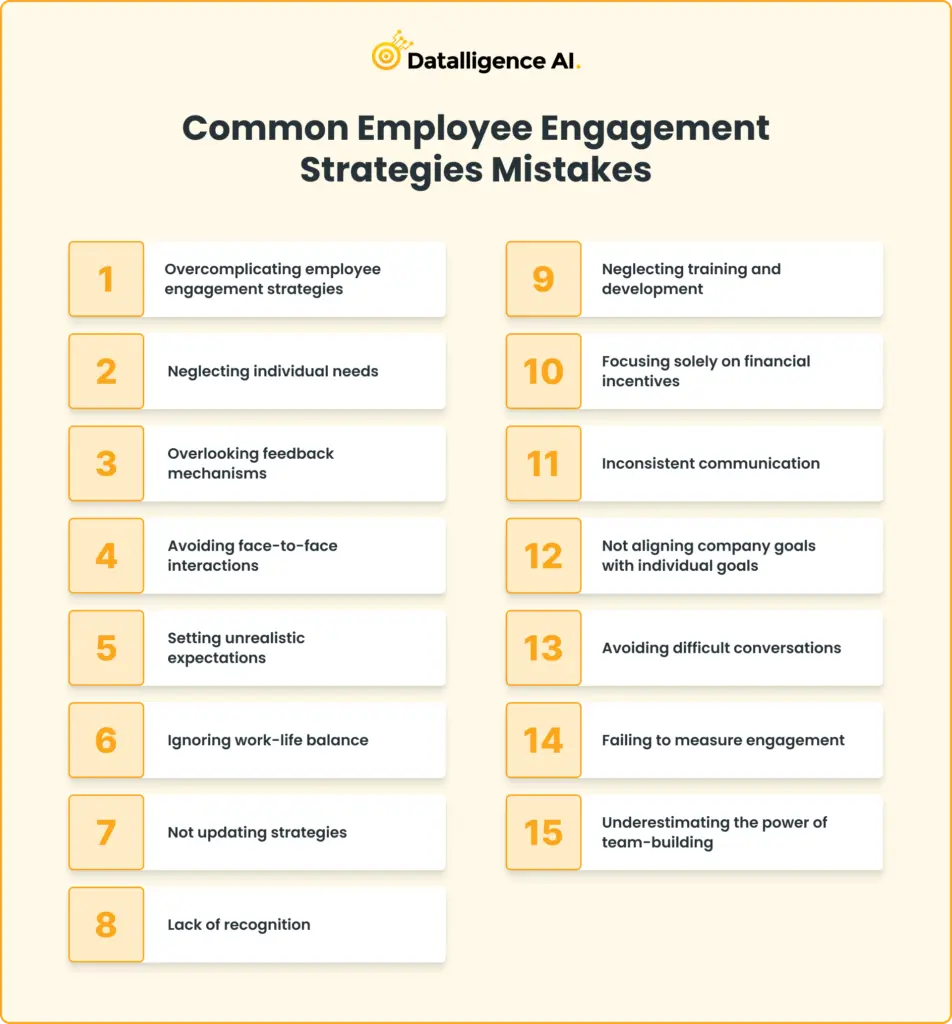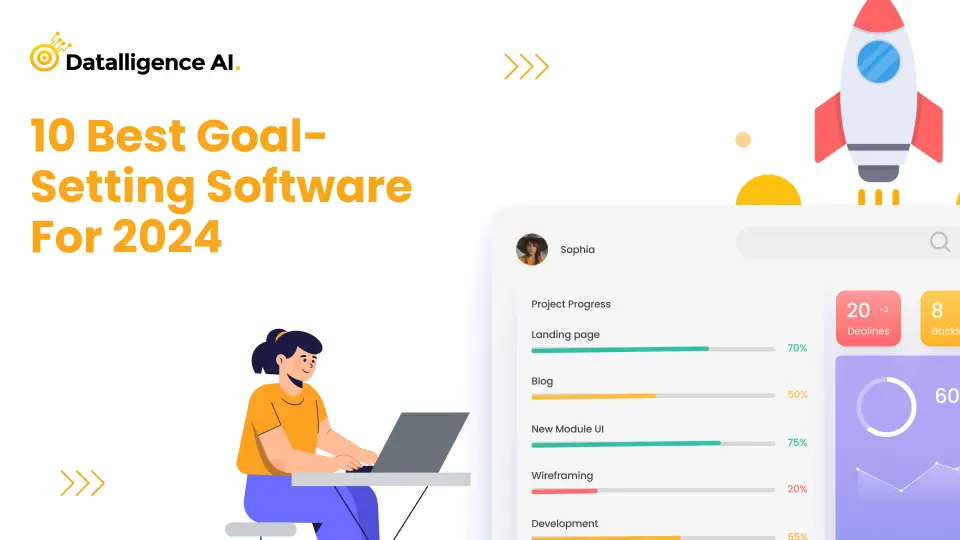Do you know that 18% of employees are actively disengaged? – Gallup
In the modern corporate world, the connection between employee satisfaction and business success is undeniable. Engaged employees lead to a more productive, innovative, and resilient organization. The question is, how can we keep the workforce engaged and motivated?
This blog delves deep into top strategies to boost employee engagement and cultivate a nurturing workplace environment.
Why is Employee Engagement Important
The success of any organization lies in the hands of its employees. Engaged employees can lead to higher productivity, improved outcomes, and a harmonious workplace. Thus, understanding the importance of employee engagement becomes pivotal.
Firstly, employee engagement is intrinsically linked to productivity. An engaged employee is passionate about their job, putting in the effort and time required to complete tasks efficiently and effectively. This results in increased outputs without necessarily increasing inputs, ensuring that organizations get more value from their workforce.
Secondly, engaged employees have higher levels of job satisfaction, which can directly influence retention rates. High turnover can be costly for organizations, not just in terms of recruitment expenses but also due to the loss of institutional knowledge. Engaged employees are more likely to remain with the company, reducing these costs and ensuring continuity in operations.
Thirdly, engagement fosters a positive work environment. Engaged employees tend to be more collaborative, take fewer sick days, and contribute positively to workplace culture. This harmonious atmosphere can be infectious, further promoting teamwork and shared organizational goals, leading to overall business success.
Benefits Of Employee Engagement
Employee engagement is the emotional commitment and enthusiasm an employee has toward their job and the company they work for. This bond influences their willingness to put in discretionary effort, beyond the basic requirements of their role. A fully engaged workforce offers numerous benefits for both the individual and the organization.
Here are the advantages:
- Increases productivity as engaged employees often put in extra effort.
- Enhances employee retention, reducing turnover costs.
- Boosts workplace morale, fostering a positive environment.
- Drives higher customer satisfaction due to dedicated service.
- Encourages creativity, leading to innovative solutions.
- Reduces absenteeism as employees feel more committed.
- Amplifies team cohesion, resulting in collaborative successes.
- Improves decision-making by ensuring all voices are heard.
- Optimizes performance, leading to higher profit margins.
- Encourages continuous learning and personal development.
- Elevates overall business growth due to consistent contributions.
- Aligns personal goals with organizational objectives.
- Encourages proactive feedback, leading to continuous improvement.
- Reduces burnout and stress, promoting employee well-being.
- Boosts competitiveness in the market due to top-performing teams.
5 Best Employee Engagement Strategies

Employee engagement is more than just a buzzword. When employees are engaged, they are emotionally committed and willing to give their best at work, leading to higher productivity and lower turnover. A Gallup poll suggests that highly engaged teams result in 21% greater profitability. Clearly, businesses cannot afford to overlook the importance of engaging their staff.
So, what strategies can leaders implement to boost engagement levels?
1. Foster Open Communication
One of the fundamental pillars of employee engagement is transparent and open communication. When employees feel that their voice is heard and valued, they’re more likely to engage with their tasks and the company’s vision. Employee engagement strategies that promote two-way communication channels, such as feedback sessions, town halls, and open-door policies, are instrumental in ensuring that employees remain connected and valued.
Action Plan:
- Introduce regular feedback sessions, ensuring both top-down and bottom-up communication.
- Host quarterly town halls to share company updates and gather insights.
- Implement platforms that allow for anonymous feedback to capture honest employee sentiments.
2. Invest in Continuous Learning and Development
In today’s rapidly evolving workplace, the thirst for knowledge and growth is paramount. Implementing continuous learning opportunities is a surefire way to improve employee engagement. By offering workshops, training sessions, and opportunities for further studies, you not only increase employee skill sets but also show that the organization is invested in their personal and professional growth.
Action Plan:
- Identify skill gaps and curate tailored training programs.
- Collaborate with online education platforms or offer in-house workshops.
- Create a knowledge-sharing platform where employees can share and learn from each other.
3. Recognize and Reward Consistently:
Recognition plays a pivotal role in driving employee engagement in the workplace. Simple gestures such as a thank you note, public acknowledgment, or tangible rewards can go a long way in making employees feel valued. Strategies that embed regular recognition into the company’s culture ensure that employees stay motivated and feel appreciated for their contributions.
Action Plan:
- Launch a monthly recognition program celebrating standout performances.
- Utilize peer appreciation platforms or apps to foster mutual acknowledgment.
- Offer tangible rewards (e.g., bonuses, gift cards, extra days off) for significant achievements.
4. Prioritize Employee Well-being:
Beyond just the professional sphere, it’s essential to address the holistic well-being of employees. Employee engagement strategies that focus on mental, physical, and emotional well-being are now essential. This can include initiatives like flexible working hours, wellness programs, or counseling services. When employees feel that their well-being is a priority, they are more likely to be engaged and loyal to the company.
Action Plan:
- Implement flexible working schedules catering to diverse employee needs.
- Roll out wellness programs focusing on both physical and mental health.
- Conduct bi-annual well-being surveys to understand and cater to employee needs.
5. Cultivate a Strong Company Culture
The environment and culture in which employees work play a significant role in how engaged they feel. By fostering a culture that promotes collaboration, innovation, and a sense of purpose, organizations can improve employee engagement considerably. Regular team-building activities, inclusivity initiatives, and a clear articulation of company values can make employees feel part of something bigger than themselves.
Action Plan:
- Organize frequent team-building exercises emphasizing collaboration.
- Hold workshops reinforcing company values and their day-to-day importance.
- Ensure a focus on diversity and inclusion, providing training sessions and creating inclusive forums.
Common Employee Engagement Strategies Mistakes

How do you measure employee engagement?
Employee engagement metrics provide a snapshot of how invested and committed employees are to their roles and the organization as a whole.
Here’s a simple breakdown:
1. Employee Engagement Survey
This is the most direct way to measure engagement. Typically, employees respond to statements on a scale (e.g., 1-5, where 1 = Strongly Disagree and 5 = Strongly Agree).
Example Question: “I feel motivated to go beyond my formal job responsibilities.”
Formula: (Number of Positive Responses / Total Responses) x 100 = % Positive Engagement
2. Employee Net Promoter Score (eNPS)
This is borrowed from the traditional Net Promoter Score used for customer loyalty. Employees are asked one primary question: “On a scale of 0-10, how likely are you to recommend this company as a place to work?”
Respondents are then categorized as:
- Promoters (score 9-10): Loyal enthusiasts
- Passives (score 7-8): Satisfied but unenthusiastic
- Detractors (score 0-6): Unhappy employees
Formula: eNPS = % Promoters – % Detractors
3. Employee Turnover Rate
A higher turnover rate can indicate lower engagement.
Formula: (Number of Employees Who Left During Period / Average Number of Employees During Period) x 100 = % Turnover Rate.
4. Participation in Voluntary Activities
This can be things like attendance at optional training, participation in company events, or involvement in employee resource groups.
Formula: (Number of Employees Participating / Total Number of Employees) x 100 = % Participation Rate
5. Utilization of Employee Benefits:
How often employees utilize available benefits can be a good indicator of their engagement and awareness.
Formula: (Number of Employees Using a Specific Benefit / Total Eligible Employees) x 100 = % Utilization Rate
How Datalligence Can Bolster Your Employee Engagement:
To really take the lead in the race for optimal employee engagement, you need insights, analytics, and data-backed decisions. This is where Datalligence comes into play. Datalligence offers cutting-edge solutions to measure, analyze, and improve employee engagement. With actionable insights at your fingertips, you can:
- Easily track and review employee performance, ensuring everyone is aligned with company goals and recognized for their contributions.
- With tools tailored for seamless communication, Datalligence makes it easy for teams to stay connected, share feedback, and collaborate effectively.
- Plan and monitor continuous learning opportunities for your employees, ensuring they’re always at the forefront of industry knowledge.
In conclusion, employee engagement is not just a buzzword. It’s a strategic necessity. By leveraging the above strategies and incorporating data-driven insights from Datalligence, you can create a workplace environment where everyone thrives, both in spirit and in action.











